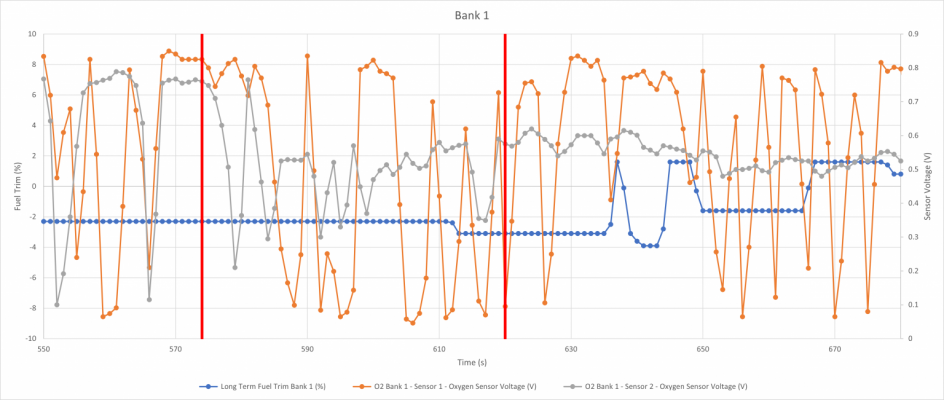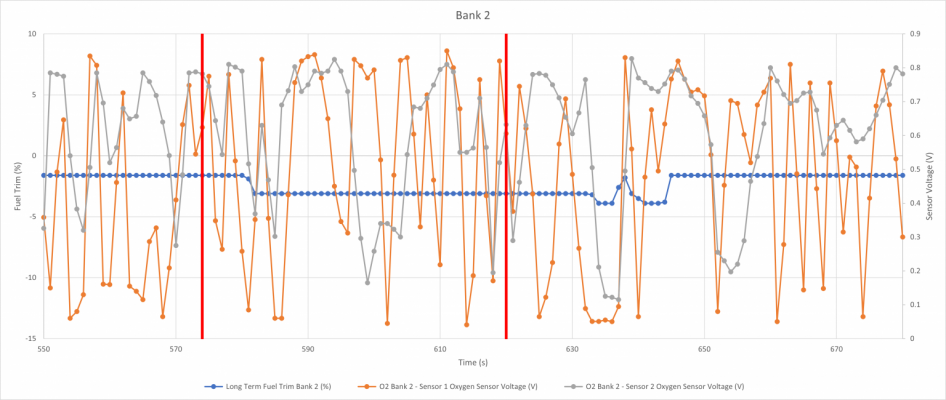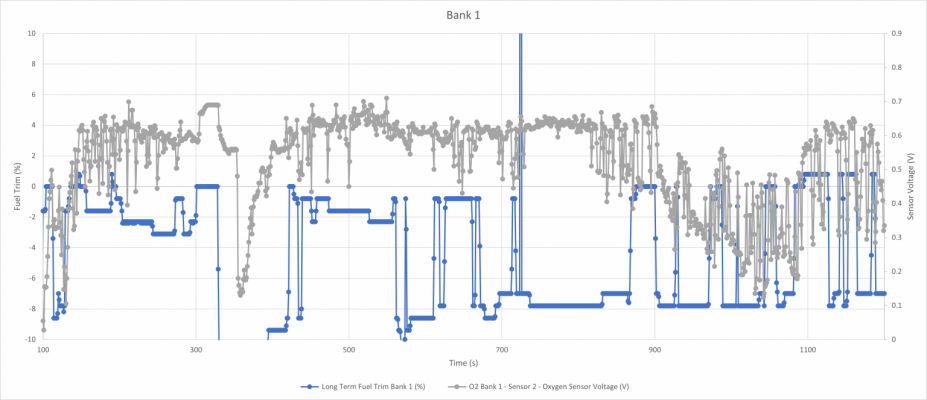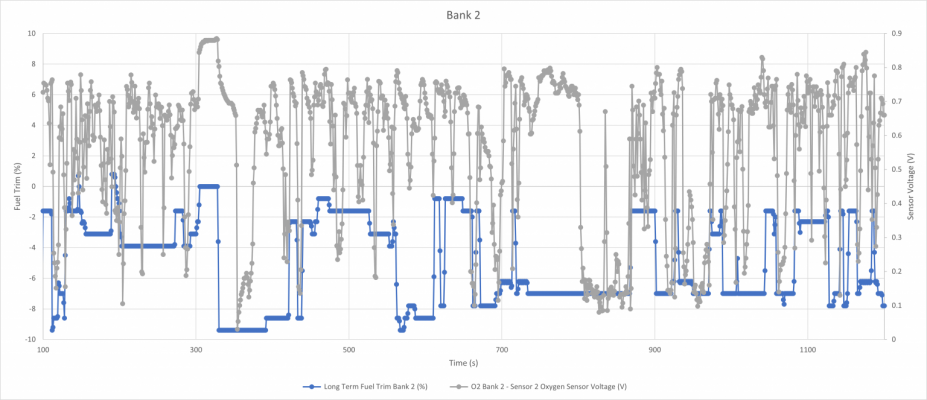Hi everyone,
So I shortened the gap on all of my spark plugs to 0.050". After putting them back in, I floored it up a hill again and got her to misfire. You'll see in those pictures that it doesn't look any different than what I've posted before. Again, between the vertical red lines is where the misfires occurred. This time the code flashed for a cylinder 5 misfire - not multiple like it normally does.
What's weird is on the way home my downstream O2 sensors looked like they were doing a lot better. In those pictures I am showing the entire trip and turned off the upstream sensor data points to present it a little better. It looks like things look a lot better after I regapped and put her through some heavy load although the fuel trims seem a bit low.
Here's where I'm at with all of this right now: I'm going to clear my P0305 code and hope that I stop getting the P0420 code for the foreseeable future. I can live with the engine misfiring under extreme conditions but as long as my car thinks the cats are fine, then that's good enough for me.
However, I'm still open to suggestions and ideas since I don't feel like I've completely solved things. I think the next step may be to shorten the gaps again (to 0.045"), but I'm curious to hear what everyone else thinks of this so far. I was also convinced by an auto store salesman to buy Cataclean and I might try doing a cycle of that just for S & Gs (I still have the receipt).
Hello Big_Red9,
I kinda lost sight of this thread while diving down other rabbit holes. Apologies.
Overall, I like what you have proposed above. I concur with stepping the plug gaps down to .045".
This will also give you an opportunity to see if we are still getting strange porcelain color on adjacent plugs?
(BTW, might have missed it, but which new plugs did you end up going with?)
So this evening I spent a little more time boning up on Oxygen Sensor waveforms and how to interpret
the data contained in the graphs, The simple graph in reply #18 was a start, but as someone who learned
his best troubleshooting trick on Sesame Street ("One of these things is not like the other") I found a
great screen shot where they are troubleshooting a car with a V engine, has separate Bank 1 and Bank 2
cats...and we can compare & contrast what a good cat vs a bad cat looks like while bracketed by the
Upstream and Downstream O2 sensors:
You must be registered for see images attach
(credit: Scanner Danner cat troubleshooting video.
LINK)
I haven't watched the entire video, but so far so good. But after watching what I have I
can now see that you have 1 cat working better than the other one. And my troubleshooting
instincts tell me that the wounded cat is behind the problem cylinder(s).
But instead of just blurting out what I think, instead I'd like you to put eyes on your most recent
graphs in reply #35, see if you identify the same cat as the one having the most trouble, and
then tell me which 4 cylinders are feeding into it? And is there any correlation between the
2 plugs with the mystery deposits and the weakest cat?
This way, instead of me possibly misdiagnosing and steering the conversation the wrong way,
instead we independently analyze the data and then compare our results. (We used to sometimes
put 2 independent teams on a really tough plane {1 dayshift, 1 night shift} and then the next
morning compare the results of what both teams came up with. A lot of times we'd get additional
insight from the differences in what the 2 teams observed, instead of the shop just adopting 1 person/team's
opinion and everyone running with that. Does this make sense?)
****
One of my friends who works at the O'Reilly's that I usually buy parts from highly recommended Cataclean to me, when the Suburban was throwing codes on its O2 sensors. The passenger side upstream sensor is still the original, unless it was replaced before we bought the Burb in 2013. I've replaced the driver's side upstream sensor twice (second time within a year of the initial replacement, so it was warrantied out). The downstream ones have been replaced a couple times each, but neither one in the last few years. One thing she said that you have to do with the Cataclean, is only put it in a low gas tank, a quarter tank or less. I'd just filled it up, so I didn't get the Cataclean, and in a few days the massive oil leak happened. So it's kinda not a priority at the moment...
Also, do not combine or mix the Cataclean product with any other fuel additive or cleaner as adverse reactions may occur!
I spent a couple of years moonlighting at one of the parts chains, some counter, and some parts delivery to our
commercial customers. Pretty quick you figure out which mom & pop garages practice disciplined troubleshooting,
and which retail chain tire joints employ rookie mechanics who just parts cannon everything.
Anyway, I had a couple of the good-guy mechanics (who had already demonstrated to me their troubleshooting chops)
order Cataclean to get the P0420 codes to clear on their customer's car
after they had repaired the original engine
misfire that originally caused the cat complaints. On subsequent deliveries I would always ask afterwards if it worked,
and it seemed that unless the cat had physically melted down inside, the Cataclean got the cats back and running
well enough to turn the light off, stay off, and get a NY inspection sticker. (!)
As HotWheelsburban described, you don't just throw it in a full tank and dilute it out. You gotta follow the instructions
on the can closely. Back in the store, word of mouth had spread, and customers were buying the Cataclean, and
when they came back for something else I'd ask them if it worked, and the general consensus was that it did.
(Worked as in 'got light to stay out so that they could get a new sticker'.) Long term results? Unknown.
But in the interest of science once I give myself the gift of live data I am interested of getting before (Cataclean)
and after graphs to see if I can see a discernible difference on the chore truck under controlled conditions.
****
Anyway, go ahead & watch that ScannerDanner video, see if you can discern a difference between your 2 cats,
and tell me which cylinders feed into that cat. And also gap your plugs down, and if you see anything on your
new plug porcelains please take a photo & share it so that we can see it also.
For what it's worth, without your live data graphed out the only recourse we'd have at this point is to
throw parts at it. Instead, we get to tighten up the problem description first, which is always a more
affordable/less frustrating/good approach to keeping one of these old gals on the road.
If we study this closely enough, we should be able to locate the root cause of your misfire, fix that,
then try the Cataclean & see where we end up.
In a best case scenario, not only do we step intelligently through your problem, but we eventually end
up with much better looking downstream O2 sensor graphs -AND- the P0420 stays out.
Looking forward to your next status report.
Best of luck.
Cheers --





